When planning to beautify your outdoor living space, petunias make a wonderful addition to any landscape. Luch plants overloaded with vibrant colors are a surefire way to bring your outdoor areas to life. But do petunias like sun or shade? To enjoy thriving petunias this summer season you need to know this all-important answer in order to get the best out of your plants.
Petunias prefer full sun, so plant them in an area where they will get at least 6 hours of direct sunlight per day.
Petunias are one of the easiest to grow and most colorful flowers to grow in your garden. Keep reading to find out more about petunias and their need for sun.

Petunias – The Ultimate Sun Worshippers
From small to larger blooms, there are many different varieties of petunias. For any variety, petunias like sun and lots of it. They are the ultimate sun worshippers that will produce tons of gorgeous blooms in just about any color. Whether adding petunias for a pop of color in a general landscape to using as an exclusive groundcover, plan to put them in an area that provides as much direct sunlight as possible.
Do Petunias Grow in Partial Sun or Shady Areas?
While petunias do best with full sun, they will also grow in partial sun or even somewhat shady conditions. Although petunias will bloom and grow with less than full sun, they may not flower as much as those that receive more direct sunlight. In fact, the less sunlight, the fewer petunias blooms. When planted in shadier conditions, the risk of root rot and/or fungal-related issues increases as well.
While petunias are resilient and require little more than well-draining soil after an occasional drink of water, the amount of sun is really what determines how healthy your plants will be.
Effects of Growing Petunias in Part-Shade to Full Shade

After the threat of hard frost passes, plant your petunias in the sunniest of outdoor locations. Here are some of the ways to tell if petunias are not getting enough sun:
Sparse, “spindly” or “leggy” plants
The main way to tell if petunias need more sunlight is when the plant thins out. When this happens, you can see right through the plant and see the stem “legs” instead of admiring lush, green foliage and lots of flowers.
Lack of blooms
Another way to tell that petunias are begging for more sunlight is the number of blooms on the plant. If the plant barely flowers or produces no flowers at all, it probably needs more sun.
Yellow leaves

If leaves on a petunia plant turn yellow, it could be a sign of either over- or under-watering. It can also be an indication that the plant needs more sun. This is especially true of ground-cover petunias in partial sun or potted petunias that need to be moved to a sunnier location.
Overly moist soil conditions

Another reason that more direct sunlight is important is that it helps dry out overly moist soil. The soil found in shadier spots tends to hold moisture longer than soil in sunnier areas. Petunias do their best in semi-dry soil that is not typically found in semi-shady locations.
When petunias are planted in soil that is too moist, it puts the plants at risk of developing root rot, crown rot or the possibility of fungus-related issues that prohibit healthy plant growth and blooms.
How Many Hours of Sun do Petunias Need?

Petunias thrive in full sunlight. Full sunlight is defined as six or more hours of direct sunlight per day. Note that this doesn’t have to be six consecutive hours of sunlight, just a total of at least six hours over the course of a day. If early morning sun greets your petunias for a few hours and then again re-visits them for a few hours in the late afternoon, the plants will do well.
Partial sunlight is defined as four to six hours of direct sunlight. Plants located under trees, bushes or on the side of a structure may not be able to get full, direct sunlight for six or more hours per day.
Should you use Lights when Caring for Indoor Petunias?

If you’ve ever tried starting petunias from seed with a plan to transplant them outdoors after the danger of frost is over, give yourself at least 10 weeks to allow the plants to germinate properly. During the germination period, the petunia seedlings need a lot of light to take healthy root and be strong enough for transplanting.
It’s also possible to dig up outdoor petunia plants in fall and bring indoors for care during the colder months.
Although a sunny window is the best spot for maintaining indoor petunias, even the sunniest of windows in extremely cold climates can put a petunia’s survival rate at risk.
Depending on the climate and amount of sunlight during winter months, artificial lighting provides the extra boost of light those indoor petunias need to prosper.
If the plants are depending on artificial light, keep them under the lights for a minimum of 14 hours per day. Petunias love warmth and light, so keeping the plants in a warm spot of between 60- and 70-degrees Fahrenheit is best for optimal maintenance and growth until they can go back outdoors.
Grow Bright and Beautiful

Now that you know how much petunias like lots of full sunshine and thrive because of it, you’re well on your way to cultivating a wonderfully colorful garden. Petunias are the perfect flower for beginning gardeners because as you learn and play around with just the right mix of food, water, and sun, they will grow and thrive.

